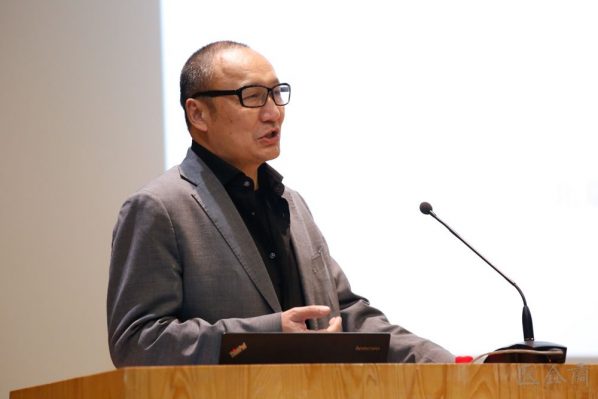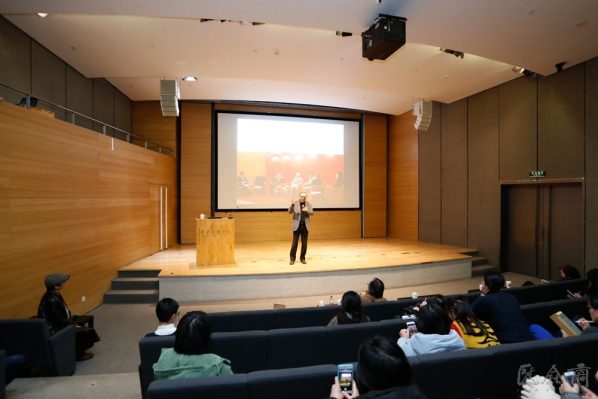
The speaker Prof. LaoZhu from the Department of History, Peking University
On the 100th anniversary of the founding of the Central Academy of Fine Arts, a number of commemorative events have been prepared for 2018, including a special exhibition of Xu Beihong and a series of academic lectures. At 6:30 pm on March 9, the first round of the series of lectures invited the speaker Prof. LaoZhu from the Department of History, Peking University, to give a lecture entitled “Archival School – The Ideas and Methods of the Compilation of Xu Beihong’s Chronicle” in the Auditorium of CAFA Art Museum, this event was presided over by Guo Hongmei, Director of Theoretical Publishing Department at CAFA Art Museum. In the lecture, Prof. LaoZhu started with the communication materials of Xu Beihong and Wu Zuoren which was supplemented by literature and images that go deep into the compilation of Xu Beihong’s chronicle.
First of all, Prof. LaoZhu recalled that he had started collecting and sorting the archives at the Central Academy of Fine Arts since 1986, but the work moved to Peking University, when his relations moved to Peking University. He collaborated with Wu Ning, Secretary-General of Wu Zuoren International Foundation of Fine Arts to work on the modern art archives, and they initially finished the archives of Wu Zuoren, Wang Chaowen, Xu Beihong, and Jiang Feng. It is precisely because of these ongoing works that they are called the “Archival School” by Prof. Yu Ding, Dean of the Institute of Arts Administration and Education, CAFA. LaoZhu bluntly stated that the concept of archive has been clear since it appeared 32 years ago. Prof. LaoZhu then explained the specific meaning of the archive. What does the archive mean? Briefly speaking, it refers to data that can be indexed, but the archives are not open to anyone at any time under any circumstance, so it encompasses secrecy and confidentiality. Up to the present day, the concept of data has begun to be combined with archives. The materials have been electronically computerized to become data, which is then stored in electronic systems as archives. The technical result of the archives is that each of its details can be found through an indexing system.

The host Guo Hongmei, Director of Theoretical Publishing Department at CAFA Art Museum (right)
Prof. LaoZhu said that there were two principles for the contemporary archives, including the principle of ecological entirety and the present non-utilitarian principle. He took the archive of artworks as an example to illustrate the principle of the ecological entirety, though this principle does not only involve the archives of the work, but also involves the methods of the creation, collection, trading, or the things that have happened in the process of the making of the work and even all the circumstances related to each creator. In addition to the general ecology, the ecological nature of art archives has a more profound nature. It has penetrated into some intangible and subtle levels of human spirit. “The present non-utilitarian principle” involves the artificial modifications of archives. In order to avoid this problem, in the construction of contemporary art archives, people record rumors, read literature, visit exhibitions and visit artists every day, which has constituted a very clear systematic work plan. It records all the private data even when it seems there is no purpose. The construction of modern archives attempts to restore the historical truth of the time. Xu Beihong’s archive is part of the construction of modern art archives.
Prof. LaoZhu and his team started Xu Beihong’s chronicle in 2009. He mentioned that many people had made Xu Beihong’s chronicle before. For example, Mr. Wang Zhen had already published two editions of chronicles in the mainland and Taiwan. Prof. LaoZhu said that Wang Zhen’s chronicle took priority with its value judgment, which was not desirable, for example, when he determined an individual was a bad person, he would try his best to record the bad things; when he determined that someone was a good person, he would not record this person’s bad things. In the opinion of Prof. LaoZhu, they must boost and comply with a neutral value in the work of archives and chronicles. In addition, with the development of the times, it is necessary to find three pieces of evidence for any archival material: assertive evidence, evidence, and circumstantial evidence. Take the court forensics as an example, the statement of the litigant involved in the event is called the assertive evidence. Secondly, the evidence provided by another person is called the testimony of a witness (evidence). Thirdly it is called physical evidence (circumstantial evidence), and all the things can be considered as circumstantial evidence. Speaking of the details of the compilation of Xu Beihong’s chronicle, Prof. LaoZhu said that each archival record has been verified in the process of the compiling of the chronicle, and his team have even been directly stationed in CAFA to check each record of the period when Xu Beihong worked in National Beiping Art School to his death in 1953, this would not be recorded in the chronicle until it was checked.

View of the lecture
In the lecture, Prof. LaoZhu started from Xu Beihong’s unpublished materials, to conduct an in-depth analysis of the relationship between Xu Beihong and Wu Zuoren, and the relationship between Nanguo Art College and the National Hangzhou Art School. It is worth mentioning that these materials will be exhibited in Xu Beihong’s exhibition. Wu Zuoren was a student of Xu Beihong, and they communicated closely. In March, 1930, Xu Beihong wrote Wu Zuoren a letter when Wu Zuoren was going to Europe, but Xu could not come as his brother-in-law was sick. So he wrote a letter to Wu Zuoren to encourage him to be determined. In their communication in 1939, he wrote that: “I am not a member of Communist Party, but I admired Fan Zhongyan, who had a noble spirit as the first man to worry for the future of the state and the last to claim his share of happiness, I thought that a ‘scholar’ should hold this idea on a daily basis. When the national crisis is serious, dying for a just cause will preserve one’s virtue intact.” On June 10, 1946, Xu Beihong sent a letter to Wu Zuoren, to invite him to be the head of the Department of Oil Painting and the head of Academic Affairs of National Beiping Art School. In the letter it mentioned that “The Ministry of Education hired me as the principal of Beiping Art School, so I asked my dear brother to help me. Because it is related to the future of Chinese art, please don’t decline it.”

View of the lecture
Prof. LaoZhu then showed us the letters between Xu Beihong and Wu Zuoren in the 1940s, and “China Academy of Fine Arts” is printed on the letterhead. The China Academy of Fine Arts was an academic research organization established by Xu Beihong in Chongqing, with the boxer indemnity, but it was only for research instead of enrollment. LaoZhu and Wu Ning once went to Chongqing to visit this “China Academy of Fine Arts”. Prof. LaoZhu started from “Lao Tian” who often appeared in their letters, to pursue history, and he found that Lao Tian was Tian Han, and also discovered the stories between Nanguo Art College and the National Art College, which was renamed the National Hangzhou Art School soon after it was established, namely the predecessor of China Academy of Art which took place in 1928. The newspapers of that period corroborate these incidents. Extending the discussions on this event, LaoZhu even restored the impact of the emotional disputes between Xu Beihong and Jiang Biwei on the historical development of Nanguo Art College. LaoZhu believed that the mastery of these first-hand materials, combined with the newspapers, diaries, and the later memoirs, reproduced the whole history.
At the end of the lecture, the audience asked questions and interacted with Prof. LaoZhu on the problems such as documentary records of contemporary Chinese art and how to find the three pieces of evidence.
Text by Yang Zhonghui, translated by Chen Peihua and edited by Sue/CAFA ART INFO
Photo by Li Biao (CAFA Art Museum)




























